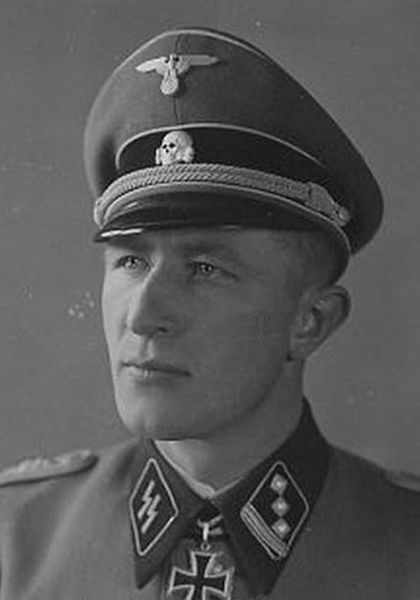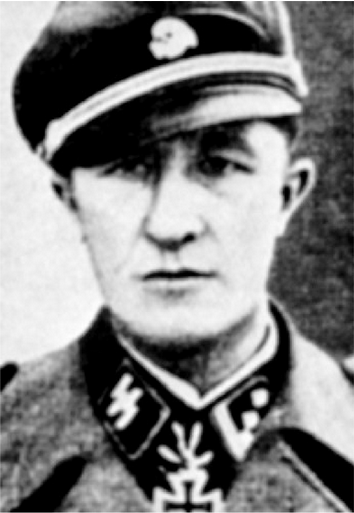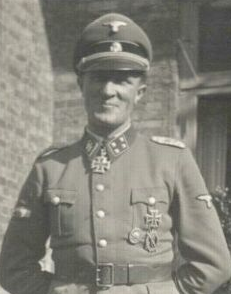Faulhaber, Markus (Waffen SS)
- Date of birth:
- July 22nd, 1914 (Schomberg/Krs. Rottweil/Württemberg, Germany)
- Date of death:
- May 11th, 1945 (Waidring/Tirol, Austria)
- Service number:
- SS-Nr.: 113.916 // NSDAP-Nr.:
- Nationality:
- German
Biography
Markus Faulhaber was born on 22 July 1914 in Zepfenhan (Rottweil), near Schömberg, Zollernalbkreis, Württemberg.
He volunteered to join the SS-VT (SS number 113,916) in 1934, and was assigned to III./SS-VT-Standarte "Deutschland" in Ellwangen (1934-1936).
Faulhaber was selected to become an officer. After he had graduated from the SS-Junkerschule in Braunschweig, he was assigned to III./SS-VT-Standarte "Germania", Radolfzell, in 1938.
He took part in the Polish Campaign, where he was awarded the Iron Cross 2nd class; and, as commander of 3./SS-InfRgt "Germania" (part of SS-Division Verfügungstruppe) in the Battle of France.
Still commander of 3./SS-InfRgt "Germania" (SS-Division "Wiking"), he also took part in the invasion of the Soviet Union, Operation Barbarossa where he was awarded the Iron Cross 1st class and the Eastern Front Medal 1941/42 awarded to all who suffered the first Russian winter of the war.
He was awarded the Knight's Cross in December 1942 while in command of the 3rd Company.
After that, Faulhaber became a member of the teaching staff (tactics instructor) of SS-Junkerschule in Bad Tölz and was promoted to SS-Sturmbannführer on 9 November 1943.
He was next involved in the formation of the SS Panzergrenadier Brigade 49 which he commanded from June to August 1944.
In April 1945 Faulhaber was given command of the 95th SS Panzer Grenadier Regiment, 38th SS Division Nibelungen when it was formed from the staff and cadets at the college and eventually surrendered to the Americans.
Markus Faulhaber drowned in the river Salzach near Waidring on 11th May 1945. He lies buried at the German War Cemetery Radolfzell, Block II, Grave 43.
Do you have more information about this person? Inform us!
- Period:
- Second World War (1939-1945)
- Awarded on:
- November 14th, 1939
- Period:
- Second World War (1939-1945)
- Awarded on:
- July 14th, 1941
- Period:
- Second World War (1939-1945)
- Awarded on:
- 1942
- Period:
- Second World War (1939-1945)
- Rank:
- SS-Obersturmführer (Lieutenant)
- Unit:
- Chef, 3. Kompanie, I. Bataillon, SS-Panzergrenadier-Regiment 9 "Germania", SS-Panzergrenadier-Division "Wiking", Waffen-SS
- Awarded on:
- December 25th, 1942
“During the thrust of the 1. Panzer-Armee to Rostov the reinforced SS-Regiment Nordland had the mission of covering the flank of the Panzer-Armee from a position north of the Tuslow river. As the 37th Russian Army delivered noticeable pressure on the 17.11.1941 in its attempts to reach the Sea of Azov, the I./SS-Rgt. Germania was dispatched to Aleksejewo—Tuslowka on the evening of the same day to reinforce the SS-Regiment Nordland.
The reinforced 3. Kompanie received orders to move to Ljubimaja and prepare for employment in a northeastern and northwestern direction on the 18.11.1941. The 8. and 12. Batterien of the SS-A.R. 5 were located in the village of Ljubimaja along with the Abteilung command post.
On the morning of the 18.11.1941 strong Russian forces succeeded in breaking through the thin defensive front of the SS-Rgt. Nordland and entering the village of Ljubimaja. The Abteilung staff was encircled and the Batterien were immediately threatened. Strong enemy elements, about 1500 men, had already gotten into the quarters of 3. Kompanie. In this grave situation the commander of 3./SS-Rgt. Germania, SS-Obersturmführer Faulhaber, alerted his Kompanie. Faulhaber sprung into the middle of the attacking Russian masses with just a few men from his Kompanie HQ squad. Inspired by this unprecedentedly bold deed by the Kompanie commander, the Kompanie immediately went over to the attack.
SS-Obersturmführer Faulhaber immaculately coordinated his troops. The battle degenerated into bitter close combat. The Abteilung staff of the IV./SS-A.R. 5 was dislodged from its position. Meanwhile 3. Kompanie stormed heedlessly into the Russians, with SS-Obersturmführer Faulhaber at their head. Part of the Kompanie was used for a flanking maneuver.
Over 300 Russian dead were counted on the battlefield of 3. Kompanie. It furthermore captured 620 prisoners as well as 1000 rifles and numerous MGs and mortars. The bold deed of SS-Obersturmführer Faulhaber annihilated 2 Russian battalions. The thrust of the Russians was not just defeated but brutally crushed in an exemplary fashion. The cold-bloodedness and personal bravery of SS-Obersturmführer Faulhaber saved the Abteilung staff and the Batterien from destruction, while also preventing an expansion of the Russian breakthrough. SS-Obersturmführer Faulhaber alone had mastered the situation. A successful enemy breakthrough here would have led to disastrous consequences for the XIV. Panzer-Korps and potentially compromised the capture of Rostov by the southern group. In this way SS-Obersturmführer Faulhaber decisively salvaged the XIV. Panzer-Korps’ less than ideal situation.
In this engagement Faulhaber was wounded by a pistol shot through the nose, but remained with his men even so. SS-Obersturmführer Faulhaber has already distinguished himself through his audacity and ruthless devotion to duty, particularly in the battles around Kuzmin and Smela, the assault on Krementschug and Dnepropetrovsk, and in the fighting for the Dnepropetrovsk bridgehead.”
- Period:
- Second World War (1939-1945)
- Period:
- Second World War (1939-1945)
- Period:
- Second World War (1939-1945)
- Period:
- Second World War (1939-1945)
Sources
- Photo 1: Wilco Vermeer collection
- Photo: Wilco Vermeer collection
- Markus Faulhaber - Vojsko.net - - FELLGIEBEL, W.P., Elite of theThird Reich, Helion & Company Limited, Solihull, 2003.
- MOONEY, PETER, Waffen-SS Knights and their Battles, Schiffer Pub Ltd, 2008.
- THOMAS, FRANZ & WEGMANN, GüNTER, Die Ritterkreuzträger der Deutschen Wehrmacht 1939-1945, Biblio Verlag, Bissendorf, 2003.
- das-Ritterkreuz.de
- Microfilm Publication A3343. US National Archives. - Markus Faulhaber | Military Wiki | Fandom












